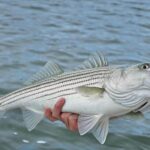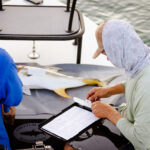
Guide to ASMFC’s Draft Addendum III for Atlantic Striped Bass
Imagery Courtesy of Sean Cobelli Media We encourage anglers, guides and conservationists to use this
For fly and light-tackle anglers along the U.S. east coast, few species attract more of a cult following than the false albacore, endearingly referred to as “albies” (and formally known as little tunny, Euthynnus alletteratus). Fast-moving, difficult to fool, and brutally hard-fighting, they have been described by anglers from Cape Cod to Cape Lookout as “the perfect sportfish,” and according to NOAA Fisheries they’re the primary target of about a half-million trips annually along the Atlantic coast. Even further south, where so-called “bonita” (a misnomer, by the way) have historically been looked down upon as a trash fish only good for bait, they’ve begun to earn respect in areas such as Florida’s Treasure Coast. Their increasingly wide acclaim, in spite of generally being viewed as less-than-stellar table fare, makes albies a prime example of a species whose value to the recreational fishing economy stems from its abundance.
Despite their popularity, we know almost nothing about false albacore biology and movements, likely due in large part to their lack of commercial value. For example, are the fish anglers target off southern New England a separate sub-population from fish found off North Carolina and Florida, or do they all represent a single well-mixed group? Do schools of fish “set up shop” in general areas for weeks at a time or are they always on the move? Better understanding the degree of population connectivity is especially urgent given emerging potential threats to this species—for example, a fishery in south Florida to supply the bait market and the rapid expansion of offshore wind energy projects in the Northeast and Mid-Atlantic.
An additional unknown when it comes to albies is the impact of recreational fishing on the species. According to NOAA Fisheries, over the past decade, anglers along the Atlantic coast have caught and released between one and two million false albacore annually. However, no research has been conducted to estimate the percentage of fish that survive after release or inform what steps anglers can take to maximize the chance of survival.
To help answer these questions, we’re thrilled to be partnering with the Anderson Cabot Center for Ocean Life at the New England Aquarium on a pilot study to acoustically tag 50 false albacore off southern New England this coming fall. We’re grateful to Orsted and Costa Del Mar for serving as the primary wind developer and industry supporters for this work, respectively, as well as to a host of additional wind developers, guides, and members of the recreational fishing community who have also agreed to be a part of this exciting research.

The technique we’ll be using for this effort, acoustic telemetry, starts with bringing the Aquarium’s scientists fishing with ASGA members to catch false albacore, which will be surgically implanted with acoustic tags. The tags emit acoustic “pings” at regular intervals, which can be detected by acoustic receivers once within a given radius—think of a cell phone (the tag) that’s constantly sending out a signal to a cell phone tower (the receiver).
In recent years, New England Aquarium scientists have been deploying and managing an array of acoustic receivers in Nantucket Sound south of Cape Cod. We’ll aim to catch and tag albies in the vicinity of this acoustic array in order to track fish as they move around that general area. This study also hopes to leverage the Aquarium scientists’ participation in a large acoustic telemetry data-sharing network that exists along the Atlantic Coast to track albie movements beyond Nantucket Sound. Thus, if a false albacore tagged in this study were to swim within an acoustic receiver array off, say, the coast of North Carolina, there’s a good chance we’ll learn about it.

In addition to being able to detect false albacore movements, acoustic telemetry can be used to determine whether specific fish survived following catch-and-release. By tracking metrics such as hook type/configuration, fight time, and handling, the research team could be able to not only estimate post-release survival but also determine what approaches maximize survival, which could then be relayed to the angling community.
We’re beyond excited to get this work underway and start gathering some key baseline information on this highly valued but poorly understood species. Stay tuned for updates later this year as we begin our field work and hopefully start collecting results!

Imagery Courtesy of Sean Cobelli Media We encourage anglers, guides and conservationists to use this

Last week, the Florida Fish and Wildlife Conservation Commission (FWC) hosted the 2025 Sea Trout Symposium.

Photo Credit: Guiding Flow TV The fishing industry has lost an icon. The family and

Earlier this summer, the Jack Project took another big step forward. On the waters of
We rely on our members and donations to keep fighting for a sustainable tomorrow in marine conservation.
GIVE THE GIFT OF FISHERIES CONSERVATION THIS HOLIDAY SEASON. SHOP ASGA GOODS THAT FUND FISHERIES RESEARCH & ADVOCACY CAMPAIGNS
JOIN ASGA IN CALLING FOR CRITICAL MANAGEMENT ACTION AFTER YEARS OF SPAWN FAILURES & POOR MANAGEMENT.
By using this website, you agree to our use of cookies. We use cookies to provide you with a great experience and to help our website run effectively. To learn more, please review our privacy policy.
8 Responses
Fabulous to see this project, much needed. I am the president of the Osterville Anglers Club on Cape Cod and we have many members that are fishing for Albies. If we can help in any way with this project please let me know. Thanks, Ken C.
Ken,
Sorry it took us a few days to get back to you.
We appreciate the offer of support. I will connect to you via email.